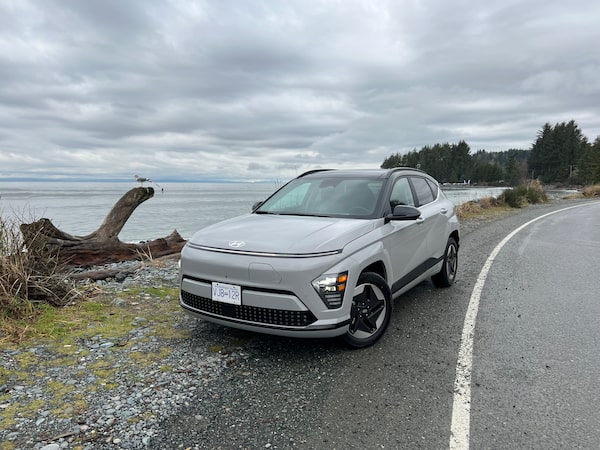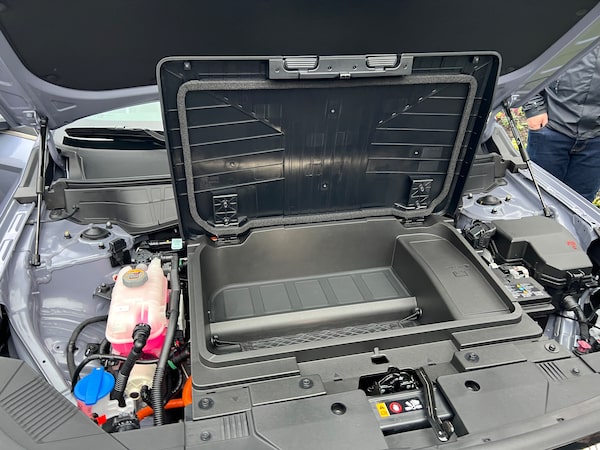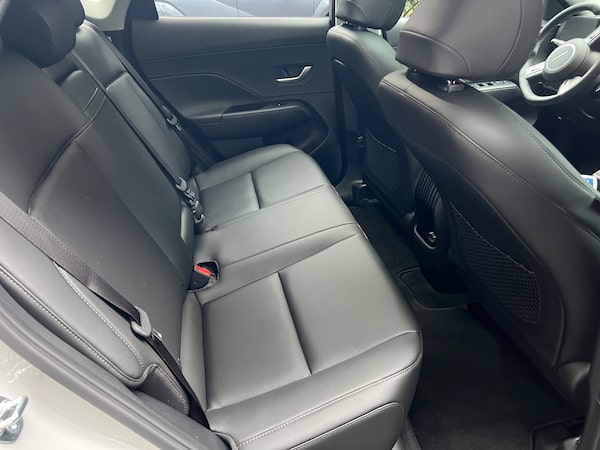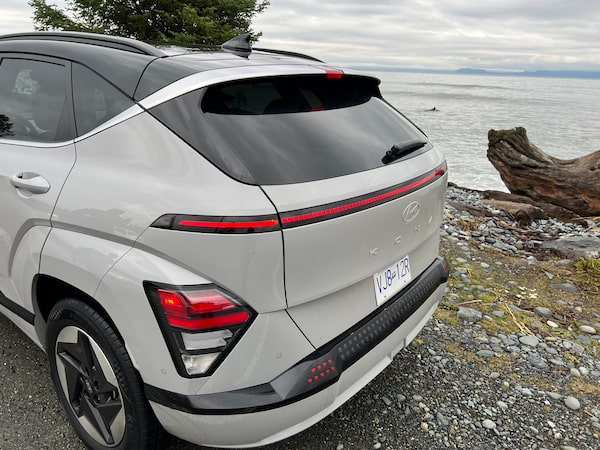
The 2024 Hyundai Kona Electric has a range of 420 kilometres.Jason Tchir/The Globe and Mail
Hyundai’s Kona Electric is growing up.
The second generation of the South Korean carmaker’s top-selling electric vehicle has more passenger and cargo room, a nicer cabin, more confident looks and better handling. Yet, even with these upgrades, the price only increased by less than $2,000 over last year.
Hyundai says the goal wasn’t to radically reinvent the Kona but to appeal to a wider group of EV buyers, although it won’t say who it’s targeting specifically.
Hyundai has sold more than 26,000 Kona EVs in the five years since its launch in 2019 – it’s the company’s best-selling EV – and it hopes to boost EV sales by 50 per cent this year.
“There’s a bit of a false narrative in [those stories of consumers turning away from EVs],” said Steve Flamand, executive director of product with Hyundai Canada. “The rate of growth has slowed down because you’re not going to grow 40 per cent every year … but the whole market is well on its way toward 25-per-cent EVs within the next couple of years.”
While the Kona is Hyundai’s cheapest EV – and still one of the cheapest EVs on the market – Flamand thinks there could be a demand for a smaller, even cheaper all-electric compact SUV, although no plans have been announced. We won’t be seeing the U.S. starter-model Kona EV with a smaller 48.6-kilowatt-hour battery, though. That’s because its 322-kilometre range doesn’t make sense for Canada, Flamand said.
Designed first as an EV
For the Kona’s second generation, Hyundai designed it first as an EV and then adapted it for a gas engine. So, it’s now more aerodynamic and has a flat floor in the back row.
While it has the same battery and electric motor as last year – both have been tweaked – the better airflow means the new Kona has five kilometres more range (it’s now 420 kilometres), even though it’s bigger.
How much bigger? It’s 15 centimetres longer, 2.5 centimetres higher and 2.5 centimetres wider. The wheelbase has stretched by six centimetres.
That’s most noticeable inside, where there’s now 7.7 centimetres more legroom in the back seat. Cargo room has grown by 179 litres – a 33 per cent increase.

The new 2024 Hyundai Kona Electric now has a small frunk that can hold a laptop.Jason Tchir/The Globe and Mail
Under the hood, there’s now a modest frunk – it can hold a laptop or maybe a small briefcase. It now has one-pedal driving – Hyundai calls it the i-Pedal and you can turn it off. Hyundai has lowered the maximum torque to make it feel more tame on the road for buyers not used to an EV’s instantly available torque.
The battery can now charge from 10 per cent to 100 per cent at a Level 2 charger in about six hours instead of nine. It can now get from 10 per cent to 80 per cent at a DC fast charger in 43 minutes instead of 47.
It still looks and drives like a Kona, but it might appeal more to buyers needing a little more room – and who don’t want to spend $50,000 on a car with a cheap-feeling interior. There are still only two trims: preferred ($46,399) and Ultimate ($51,199).

The back seats of the 2024 Hyundai Kona Electric.Jason Tchir/The Globe and Mail
It should be on dealer lots across Canada this month, Hyundai said. It qualifies for full federal and provincial EV rebates.
Tech specs
2024 Hyundai Kona Electric
- Base price/as tested: From $46,399 / $51,199, plus $1,925 for freight and pre-delivery inspection. (Not including federal and provincial rebates.)
- Powertrain/battery: 150-kilowatt electric motor on front wheels with 201 horsepower / 64.8 kilowatt-hour battery
- Drivetrain: Electric front-wheel drive
- Energy consumption/range (Litres equivalent per 100 kilometres): 1.8 city/2.3 highway/2.0 combined / 420 kilometres
- Alternatives: Chevrolet Bolt EUV, Kia Niro EV, Nissan Leaf, Volvo EX30

The 2024 Hyundai Kona Electric has a new, bolder look with horizontal LED running lights on the front and rear.Jason Tchir/The Globe and Mail
Looks
The Kona EV hasn’t entirely lost the rugged cuteness of the first generation, but it looks more mature. While it’s more conventional-looking than any of the Ioniqs, it still has character, owing to the horizontal LED running lights on the front and rear.
Performance
Hyundai used the word smooth to describe the Kona on the road – and it fits. On winding roads past Sooke, about 40 kilometres from Victoria, the Kona EV had plenty of pep to pass vehicles, but, unlike the outgoing version, it didn’t surge ahead with the lightest push on the accelerator. It’s a little less fun, but it should appeal more to buyers used to driving a gas-powered SUV. The regenerative braking is less abrupt than before – it didn’t feel like I was hitting the brakes every time I eased off the accelerator. It slows down more gradually. The level of regen is still controlled by paddles on the steering wheel, but they can now also activate one-pedal driving and an auto mode that adjusts regenerative braking based on the flow of the traffic in front of you. I had to use brakes a couple of times with one-pedal driving to keep from coasting through a stop sign.

Interior space between the seats on the 2024 Hyundai Kona Electric.Jason Tchir/The Globe and Mail
Interior
While it’s only a little bigger than the outgoing Kona EV, it feels cavernous by comparison. There’s now a big, open centre console between the driver and passenger seats – but the covered centre bin is gone. The only covered place to hold your stuff now is in the glove compartment. The push buttons to change gears are gone, thankfully, and replaced with a stalk on the steering wheel. It’s designed so you can’t accidentally shift into reverse while trying to turn on the wipers. Over all, it doesn’t feel like the interior of a $25,000 car – roughly the starting price of the gas Kona – any more. It’s comparable to interiors of gas-powered SUVs in this price range. The plastics feel higher-end and all the controls are where they should be. It uses the same side-by-side dual-screen layout as the Ioniq 5 and 6, but they look more at home here. There’s a volume knob and buttons for heating and cooling. The back seat is roomy for a compact SUV – three adults could sit back there without too much complaining – and there’s plenty of headroom. Heated front cloth seats are standard. The top trim adds leatherette and cooling for the front seats.

The dash of the 2024 Hyundai Kona Electric uses the same side-by-side dual-screen layout as the Ioniq 5 and 6.Jason Tchir/The Globe and Mail
Technology
A heat pump is standard and the battery preconditioning now both heats and cools the battery as needed to get it to the best temperature for charging (previously, the Kona EV just heated the battery). Safety tech including lane-keeping assist, automatic emergency braking, automatic high beams, rear cross-traffic alerts and adaptive cruise control are standard. The infotainment system – with a faster processor and 12.3-inch touchscreen – is still one of the easiest to use on the market. Navigation is standard. Voice controls work well and the Kona EV now accepts over-the-air software updates. Also standard is Hyundai’s blue link, which lets you remotely find the car, lock and unlock it, turn on the climate-control system and start charging from a smartphone app. Wireless CarPlay and Android Auto are standard, but you need the top trim for wireless phone charging. The top trim also adds a digital key, which lets you touch a phone or smartwatch to the doors to open it, a head-up display that projects onto the windshield and a remote control mode that lets you move the car forward and back into tight parking stalls.
Cargo
It’s 723 litres with the rear seats up and 1,803 litres with them down. There’s no more need for restraint at Costco.
The verdict
Having gained more passenger and cargo room without losing range, the 2024 Hyundai Kona delivers more bang for your buck than ever – and you’ll pay less than nearly any other EV on the market.
The writer was a guest of the automaker. Content was not subject to approval.
Shopping for a new car? Check out the new Globe Drive Build and Price Tool to see the latest discounts, rebates and rates on new cars, trucks and SUVs. Click here to get your price.